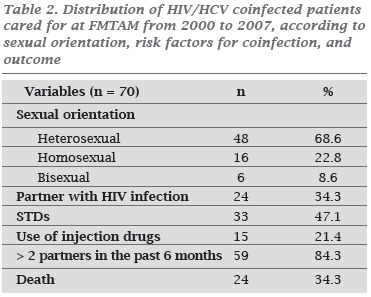The association of HIV infection and hepatitis C virus (HCV) infection often occurs because both viruses share the same transmission routes, increasing the possibility of HIV/HCV coinfection. World prevalence greater than 30% of coinfected cases is estimated, and it can reach 90% depending on the transmission route. With the aim of determining the frequency and profile of HIV/HCV coinfected patients, a descriptive analysis was carried out with patients with HIV/AIDS whose serology was positive for hepatitis C virus (HCV), cared for at the Fundação de Medicina Tropical do Amazonas from 2000 to 2007. In the present study, of the 2,653 AIDS cases notified in SINAN, 1,582 patients underwent serology test for hepatitis C, and a frequency of 4.42% (n = 70) of HIV/HCV coinfected patients was identified in the period studied. The most frequent infection route was sexual transmission (84.3%), 68.6% among heterosexual individuals. Most patients were males (72.9%), aged between 25 and 40 years (60.1%), of low income (50% earning up to one minimum wage), and low educational level (80% had completed only middle school). A high percentage of deaths were observed during the study (34.3%). The results indicate a low seroprevalence of HIV/HCV coinfection in this population, in which sexual transmission, characterized by sexual promiscuity among heterosexual individuals, is the major transmission route of the virus rather than the use of injection drugs, as shown in world statistics.
coinfection; hepatitis C; HIV; epidemiology; transmission



